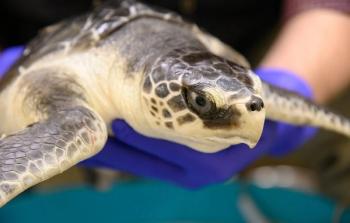
Discovering a new dinosaur species: Dracorex hogwartsia
In retrospect, I realize now that it all began when my grandmother gave me a mammoth's molar-my first fossil.
In retrospect, I realize now that it all began when my grandmother gave me a mammoth's molar—my first fossil. Paleontologic avocations run in my family—my dad treated my brothers, Tim and Steve, and me to frequent bivalve and crinoid fossil hunts in different quarries around Omaha, Neb. During one early hunt in South Dakota, I spied an object everyone else just walked by—a huge Edmontosaurus femur sticking right out of the ground! I was hooked.
Dr. Patrick Saulsbury holding his team's phenomenal find.
A flatly unique findâ¦
My passion for paleontology is shared by Steve and my good friend Brian Buckmeier. A few years ago that passion took us to northwestern South Dakota to try to unravel the mysteries of the late Cretaceous Hell Creek ecosystem.
There, in the spring of 2003, Steve and I were finishing some excavation projects in the Hell Creek Formation. It was a hot day—windy yet quiet. Suddenly, Brian rounded a bend running full out at us yelling, "Skull! Skull! Skull!" Steve and I raced back with him to the site. There we found an amazing ventral portion of maxilla with teeth and several node-like osteoderms (bony deposits that served as armor). We meticulously mapped the site and collected all the surface bone, and then we casted the skull.
The teeth and osteoderms told us we had a pachycephalosaur skull, but we had no idea that it was special. Pachycephalosaurs are bipedal herbivores that lived during the late Cretaceous period.
We donated our fossils to The Children's Museum of Indianapolis because Steve had fond memories of taking his daughter Allie there, and we knew plans were under way for a new museum building. Initially, the museum officials were not excited about our fossils—it took a few weeks to convince them we didn't have cow bones.
It wasn't until a year later that staff and consulting paleontologists at The Children's Museum told us the astounding news that it was probably a new genus or subfamily of Pachycephalosaurus. Most pachycephalosaurs are known for their dome-shaped skulls; however, our dinosaur had a flat skull covered in small bony warts. It is the first of its kind found in North America.1
â¦named in honor of Harry Potter
Dracorex hogwartsia is the first dinosaur named by committee—our team, museum officials, a paleontologist, hundreds of children, and author J.K. Rowling all contributed. Dracorex hogwartsia translates to Dragon King of Hogwarts, and it reflects that the dinosaur resembles a dragon and honors the imagination that the Harry Potter books—which mainly take place at a wizards' school named Hogwarts—instill in children. At the skull's unveiling in May, a large group of children attended. One boy who was just beaming came up to Brian, Steve, and me. "I just knew there were dragons!" he said.
A future in the past
My life hasn't changed much since the discovery of Dracorex hogwartsia. Many of my clients know about it, and their support has been great. A few clients, however, would like to see me in the hospital more and in the field less! But my familial paleontologic avocations remain. I want to continue to improve my knowledge base and contribute the best I can to the wonderful science of paleontology. I would like to think that our team is not a one-hit wonder. I know there are other great discoveries out there waiting.
I hope Dracorex hogwartsia will add a tremendous amount to our understanding of dinosaur diversity. There is so much we can learn from this dinosaur. It will likely help to redefine the pachycephalosaur family tree. It will certainly stimulate some vigorous debate—it is just beginning.
REFERENCE
1. Bakker RT, Sullivan RM, Porter V, et al. Dracorex hogwartsia, n. gen., n. sp., a spiked, flat-headed pachycephalosaurid dinosaur from the Upper Cretaceous Hell Creek Formation of South Dakota. In: Lucas SG, Sullivan RM, eds. Late Cretaceous vertebrates from the western interior. New Mexico Museum of Natural History and Science Bulletin, 2006;35:331–345.
Patrick Saulsbury, DVM, is a 1991 graduate of Iowa State University College of Veterinary Medicine. He has worked in private practice for 15 years, and he owns Siouxland Animal Hospital and Singing Hills Animal Hospital in Sioux City, Iowa.
Tell us a story about your multifaceted life! E-mail
Newsletter
From exam room tips to practice management insights, get trusted veterinary news delivered straight to your inbox—subscribe to dvm360.




